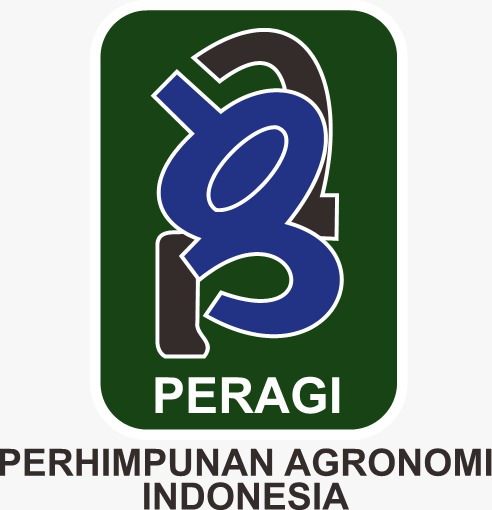Applying Biochar and Oil Palm Seeds' Resistance to Drought Stress
Abstract
Biochar is a soil enhancer because it contains macronutrients and has a high water-holding capacity. Research on the application of biochar and resistance of oil palm seedlings to drought stress was conducted to determine the dosing effect of oil palm shell biochar and watering intervals on the growth of pre-nursery oil palm seedlings under drought stress. The research was conducted in Sialang Godang Village, Bandar Petalangan District, Pelalawan District, Riau Province. The study was conducted in April 2021 – July 2021. The research used a completely randomized design (CRD) with two factors. The first factor was using biochar doses of 5 levels, namely 0 g, 50 g, 100 g, 150 g, and 200 g. The second factor was the watering interval which consisted of 3 groups, i.e.,, watering once a day, every two days, and every three days. Observational data were analyzed using an analysis of variance, and if there was a significant difference, it was continued with the Duncan Multiple Range Test at the 5% level. The results showed that giving biochar at a dose of 200 grams of oil palm shells and watering once every two days significantly increased the fresh weight of roots while providing biochar at a dose of 50 grams of biochar/polybag and watering once every three days significantly increased the dry weight of roots. Watering once every three days significantly increased the number of secondary and tertiary roots, while treatment without biochar and 50 gram/polybag biochar significantly increased the width of stomatal openings. There was a positive correlation between soil moisture content and the number of stomata (r = 0.26), the width of the opening of the stomata, and the dry weight of the roots (r = 0.25).
Downloads
References
Jasmi. (2016). Pengaruh Pemupukan Kalium terhadap Kelakuan Stomata dan Ketahanan Kekeringan. Jurnal Agrotek Lestari, 2(2), 47–54.
Kang, J., Peng, Y., & Xu, W. (2022). Crop Root Responses to Drought Stress: Molecular Mechanisms, Nutrient Regulations, and Interactions with Microorganisms in the Rhizosphere. International Journal of Molecular Sciences, 23(16),1-26. https://doi.org/10.3390/ijms23169310
Laoli, A. B., Suryanti, S., Rusmarini, U. K., (2023). Pertumbuhan Bibit Kelapa Sawit Pre Nursery pada Kondisi Cekaman Kekeringan dengan Aplikasi Abu Janjang Kosong dan Beberapa Jenis Tanah. Jurnal Pengelolaan Perkebunan, 4(1), 16–22.
Maryani, A. T. (2012). Pengaruh Volume Pemberian Air Terhadap Pertumbuhan Bibit Kelapa Sawit Di Pembibitan Utama. Fakultas Pertanian Universitas Jambi, 1(2), 64–74.
Mohamed, M., & Yusup, S. (2021). A review on sustainability and quality of biochar production from oil palm biomass in Malaysia using thermal conversion technology. E3S Web of Conferences, 287. 0–5. https://doi.org/10.1051/e3sconf/202128704011
Neoriky, R., Lukiwati, D. R., & Kusmiyati, F. (2017). Pengaruh pemberian pupuk anorganik dan organik diperkaya N, P organik terhadap serapan hara tanaman Selada (Lactuca sativa. L). Journal of Agro Complex, 1(2), 72-77. https://doi.org/10.14710/joac.1.2.72-77
Nurida, N. L. (2014). Potensi Pemanfaatan Biochar untuk Rehabilitasi Lahan Kering di Indonesia (Potency of Utilizing Biochar for Dryland Rehabilitation in Indonesia). Jurnal Sumberdaya Lahan Edisi Khusus, 57–68.
Pirasteh-Anosheh, H., Saed-Moucheshi, A., Pakniyat, H., & Pessarakli, M. (2016). Stomatal responses to drought stress. Water Stress and Crop Plants: A Sustainable Approach, 1–2(June), 24–40. https://doi.org/10.1002/9781119054450.ch3
Riski, W. F. (2021). Pengaruh Cekaman Kekeringan Terhadap Fisiologi Dan Produksi Kelapa Sawit. WARTA Pusat Penelitian Kelapa Sawit, 26(3), 142–153.
Rusdi, I., Rauf, A., Supriadi, S., & Hidayat, B. (2020). Application of biochar from palm oil plants residues on physical properties of Ultisol. AGRITROPICA : Journal of Agricultural Sciences, 2(2), 93–97. https://doi.org/10.31186/j.agritropica.2.2.93-97
Santi, L. P. (2020). Pemanfaatan Biochar Asal Cangkang Kelapa Sawit untuk Meningkatkan Serapan Hara dan Sekuestrasi Karbon pada Media Tanah Lithic Hapludults di Pembibitan Kelapa Sawit. Jurnal Tanah Dan Iklim, 41(1), 9-16. https://doi.org/10.21082/jti.v41n1.2017.9-16
Sasmita, A., & U Septianda. (2022). Variasi Penambahan Dosis Biochar Cangkang Kelapa Sawit Terhadap Emisi Karbon Dioksida di Topsoil. Jurnal Rekayasa Bahan Alam Dan Energi Berkelanjutan, 6(2), 7–13. https://rbaet.ub.ac.id/index.php/rbaet/article/view/2903
Wijaya, A., Butarbutar, T., Hartati, W., & Maurit Sipayung, D. (2018). Biochar Yang Diproduksi Dengan Tungku Drum Tertutup Retort Memberikan Pertumbuhan Tanaman Yang Lebih Tinggi. Hut Trop, 2(1), 49–58.
Xu, X., Du, X., Wang, F., Sha, J., Chen, Q., Tian, G., Zhu, Z., Ge, S., & Jiang, Y. (2020). Effects of Potassium Levels on Plant Growth, Accumulation and Distribution of Carbon, and Nitrate Metabolism in Apple Dwarf Rootstock Seedlings. Frontiers in Plant Science, 11(June), 1–13. https://doi.org/10.3389/fpls.2020.00904
Zhang, Y., Ding, J., Wang, H., Su, L., & Zhao, C. (2020). Biochar addition alleviate the negative effects of drought and salinity stress on soybean productivity and water use efficiency. BMC Plant Biology, 20(1),1–11. https://doi.org/10.1186/s12870-020-02493-2
Copyright (c) 2023 Sri Suryanti, Andre Wibowo, Retni Mardu Hartati

This work is licensed under a Creative Commons Attribution 4.0 International License.
Authors who publish with Jurnal Agronomi Tanaman Tropika (JUATIKA) agree to the following terms:
Authors retain copyright and grant the Jurnal Agronomi Tanaman Tropika (JUATIKA) right of first publication with the work simultaneously licensed under a Creative Commons Attribution License (CC BY 4.0) that allows others to share (copy and redistribute the material in any medium or format) and adapt (remix, transform, and build upon the material for any purpose, even commercially) with an acknowledgment of the work's authorship and initial publication in Jurnal Agronomi Tanaman Tropika (JUATIKA).
Authors are able to enter into separate, additional contractual arrangements for the non-exclusive distribution of the journal's published version of the work (e.g., post it to an institutional repository or publish it in a book), with an acknowledgment of its initial publication in Jurnal Agronomi Tanaman Tropika (JUATIKA). Authors are permitted and encouraged to post their work online (e.g., in institutional repositories or on their website) prior to and during the submission process, as it can lead to productive exchanges, as well as earlier and greater citation of published work.







 More Information
More Information



